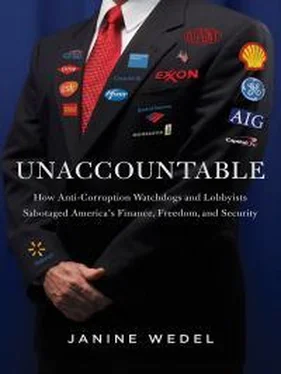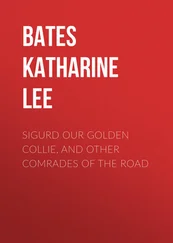Group cohesion is aided by the second feature of flex nets: shared conviction and action. Members of a flex net act as a continuous, self-propelling team to achieve goals that are grounded in their common world view. Flex nets thus differ from the powerful “Wise Men” of the American past such as the influential advisers who refashioned American foreign policy at the end of World War II and John F. Kennedy’s “Best and Brightest,” who executed the Vietnam War in the 1960s. These men were mainly instruments of the presidents whose policies they pursued, whereas flex nets are self-sustaining teams with their own agendas. There was little of the long-term constancy or independent pursuit of group goals that defines flex nets.
The third characteristic that defines flex nets is that they form a resource pool. The influence of a flex net derives in part from its members’ effort to amass and coordinate both material and interpersonal resources. As members parlay their roles and standing into influence opportunities by placing themselves in positions and venues relevant to their goals, the network as a whole can wield far more influence than an individual on his own.
While flex nets, like Mafias, work at the interstices of state and private (see, for instance, Anton Blok, “Mafia,” International Encyclopedia of the Social and Behavioral Sciences , vol. 13. Amsterdam: Elsevier, 2001, p. 9126), pursue common goals, and share rules of behavior, flex nets should not be confused with Mafias (which, in the classic usage, are a type of patronage system, run by family enterprises, that developed in Sicily and Calabria, Italy). Unlike flex nets, which primarily seek to influence policy, Mafias pursue illegal transactions to gain power or wealth and employ violence to achieve their objectives (see, for example, Federico Varese, “Mafia,” The Concise Oxford Dictionary of Politics , eds. Iain McLean and Alistair McMillan. Oxford, U.K.: Oxford University Press, 2003).
Finally, flex nets help create a hybrid habitat— their fourth feature. A flex net’s strength lies in its coordinated ability to reorganize governing processes, authorities, and bureaucracies to suit the group’s purposes. Members of flex nets both use and supplant standard governing structures, often setting up alternative might-be-official, might-be-unofficial organizations or authorities.
For all these reasons, flex nets also are not simply “cliques,” as anthropologists and sociologists have defined them (a core group whose members contact one another for multiple purposes and advance their own interests [see, notably, Jeremy Boissevain, Friends of Friends: Networks, Manipulators and Coalitions . Oxford, U.K.: Basil Blackwell, 1974, p. 174; and C. Seymour-Smith, Dictionary of Anthropology . Boston: G. K. Hall & Co., 1986, p. 40]). Although flex nets can be seen as a type of clique (Jacek Kurczewski, ed., Lokalne Wzory Kultury Politycznej . Warsaw: Wydawnictwo Trio, 2007), not all cliques possess all of the characteristics of the flex net modus operandi that define its operations.
Flex nets also are not quite political elites. While elites in many contexts do exert power and control, as anthropologists (see, for example, Cris Shore and Stephen Nugent, eds., Elite Cultures: Anthropological Perspectives. New York: Routledge, 2002; and Mattei Dogan, ed., Elite Configurations at the Apex of Power . Leiden-Boston: Brill, 2003) have shown, flex nets—small, mobile, and with a particular modus operandi —are far from synonymous with political elites. With regard to elites in the United States, important historical work has been done to dissect the structure and function of influence groups, including the networks that propel them. Political scientist Phillip H. Burch’s Elites in American History (Philip H. Burch Jr., The Civil War to the New Deal . New York: Holmes & Meier, 1981), a study of American political power from the Civil War to the New Deal, depicts the web of ties among government officials and the threat that those connections pose to the notion of democratic government. Most famously, a half century ago, in his treatise The Power Elite , sociologist C. Wright Mills (C. Wright Mills, The Power Elite . New York: Oxford University Press, 1956) coined the term to describe the pyramid of power—the tiny, singular group of elites at the pinnacle of America’s business, military, and political establishment. This interlocking constellation of government officials, military leaders, and corporate executives, he argued, effectively “controlled” major political and social decisionmaking. By contrast, members of flex nets inhabit a space that lies beyond either traditional or new positions of authority. They flex power by pooling resources within their networks and juggling roles, operating through informal channels and undermining standard process even as they work within formal institutions.
65. Personal communication with Simon Reich, professor in the Division of Global Affairs and Department of Political Science, Rutgers Newark.
66. For the definition of a “flexian,” see the earlier endnote in this chapter.
67. For my definition of a “flex net,” see two earlier endnotes in this chapter.
68. Geithner, long at the Federal Reserve Bank of New York, is now president and managing director of private equity firm Warburg Pincus; Orszag is now at Citigroup with several roles including, as mentioned earlier, “Chairman of the Public Sector Group.” The circle also includes Jason Furman, Deputy Director of the National Economic Council and later chairman of the Council of Economic Advisers in the Obama administration.
69. Matt Taibbi, “The Big Sellout.” Rolling Stone , December 1, 2009.
70. Quoted in Jackie Calmes, “Rubinomics Recalculated.” New York Times, November 23, 2008 (http://dealbook.nytimes.com/2008/11/24/rubinomics-recalculated/).
71. Rubinomics became the rallying cry for pro-business Democrats, emphasizing low interest rates through deficit reductions, free trade, and deregulation. See, for example, ibid.
Proponents of Rubinomics held that the “free market” generally knew best; that banks should be allowed to “innovate” and diversify their businesses; and that a balanced budget would help lead to lower interest rates and hence a thriving economy.
Gabriel Sherman in New York Magazine stresses the role of mindsets and shared experience as a hugely important dynamic: “Wall Street has Washington over a barrel—and the values of one can’t help but be the values of the other. Even in Democratic administrations like the current one, once and future Wall Streeters are in position to pull the teeth out of regulations—for what they see as perfectly sensible, perfectly ordinary reasons. There’s no need to cue the scary music; it’s not a conspiracy. It’s just that having lived in the same worlds, read the same textbooks, imbibed the same maxims, been tutored by the same mentors, attended the same confabs in Aspen and Davos—and, of course, been paid with checks from the same bank accounts—they naturally think the same thoughts. To these people, the way things are done is, more or less, the way they have to be done. To change the system, you have to change the people; but the people are the only ones who know how the system works” (Gabriel Sherman, “Revolver.” New York Magazine, April 11, 2011 [http://nymag.com/news/business/wallstreet/peter-orszag-2011-4/index1.html]).
72. Manuel Roig-Franzia, “Brooksley Born, the Cassandra of the Derivatives Crisis.” Washington Post, May 26, 2009 (http://www.washingtonpost.com/wp-dyn/content/article/2009/05/25/AR2009052502108.html).
Читать дальше












